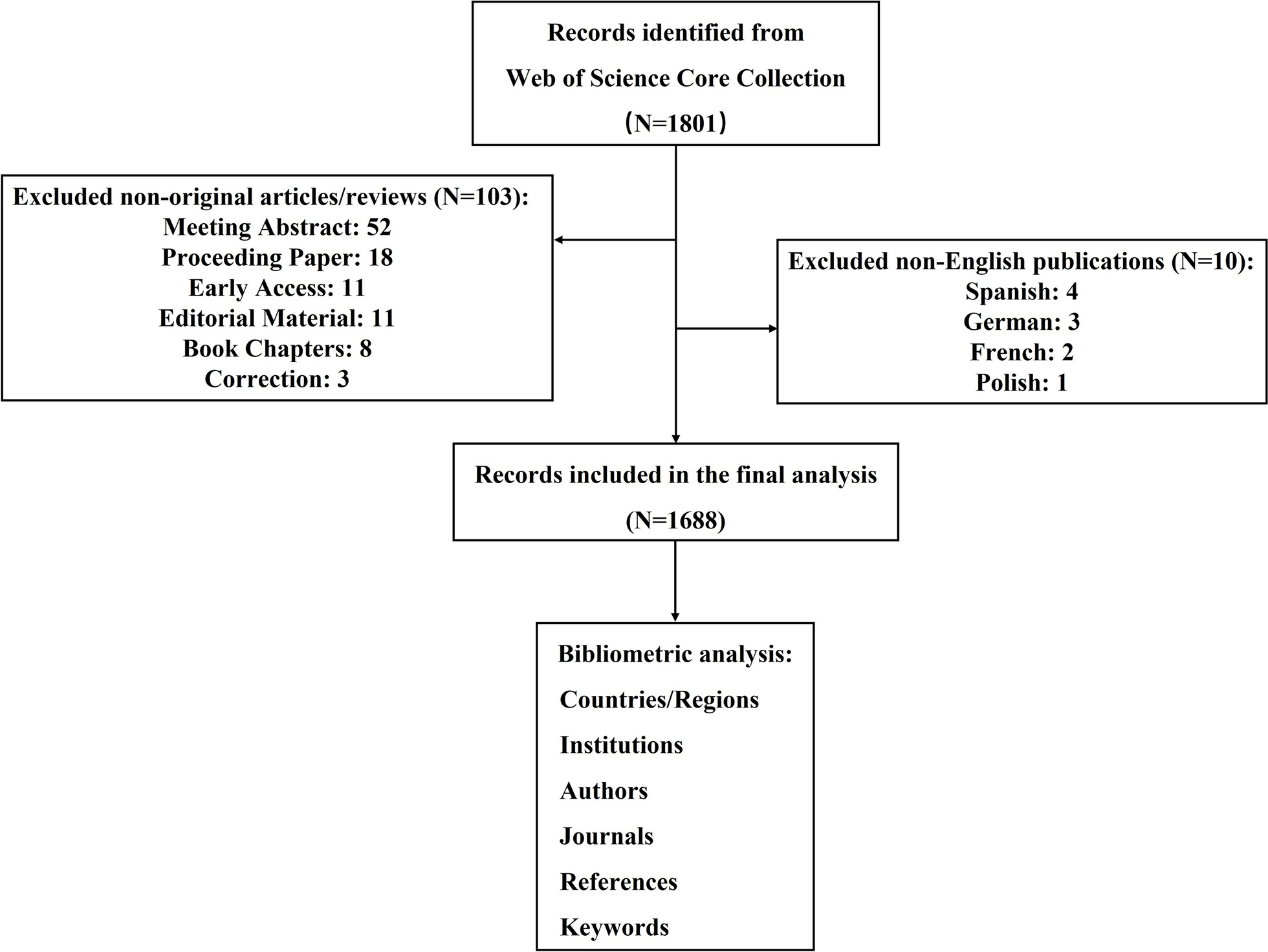Worldwide trend in publication numbers and citations
As shown in Fig. 2, the annual publication output on proteomics in obesity research from 1999 to 2025 exhibited an overall upward trend with slight fluctuations. The highest number of studies was observed in 2022 (n = 184), while the lowest was in 1999 (n = 2). Between 2004 and 2014, the annual publication output ranged from 14 to 71 articles on average. However, a noticeable surge in the number of publications occurred in the last decade, particularly from 2018 (n = 97) to 2022 (n = 184). As of the search date, the total citations for all articles amounted to 49,801. From 2010 to 2022, the annual citation count consistently exceeded 3000, highlighting sustained academic attention in this area (Fig. 2).
The number of annual publications and citation trend
Distribution and global contribution of countries/regions, institutions
Building upon the rising publication trend, we next examined the geographical distribution of research output. Table 1 summarizes the top ten most productive countries/regions in proteomics-related obesity research. As shown in Fig. 3a, the United States led with 534 publications, followed by China (n = 322) and Germany (n = 187). The U.S. also had the highest H-index (h = 72), indicating both volume and impact, with Germany ranking second (h = 42). These findings underscore the dominant role of the U.S. in shaping the field. The international collaboration network, constructed using VOSviewer and an online bibliometric platform, included 24 countries with at least 25 publications (Fig. 3b, c). Line thickness reflects the Total Link Strength (TLS), representing collaboration intensity. The U.S. demonstrated extensive partnerships, particularly with China, which emerged as its closest collaborator. In contrast, inter-country collaborations beyond these key players appeared limited, suggesting opportunities for broader global cooperation.
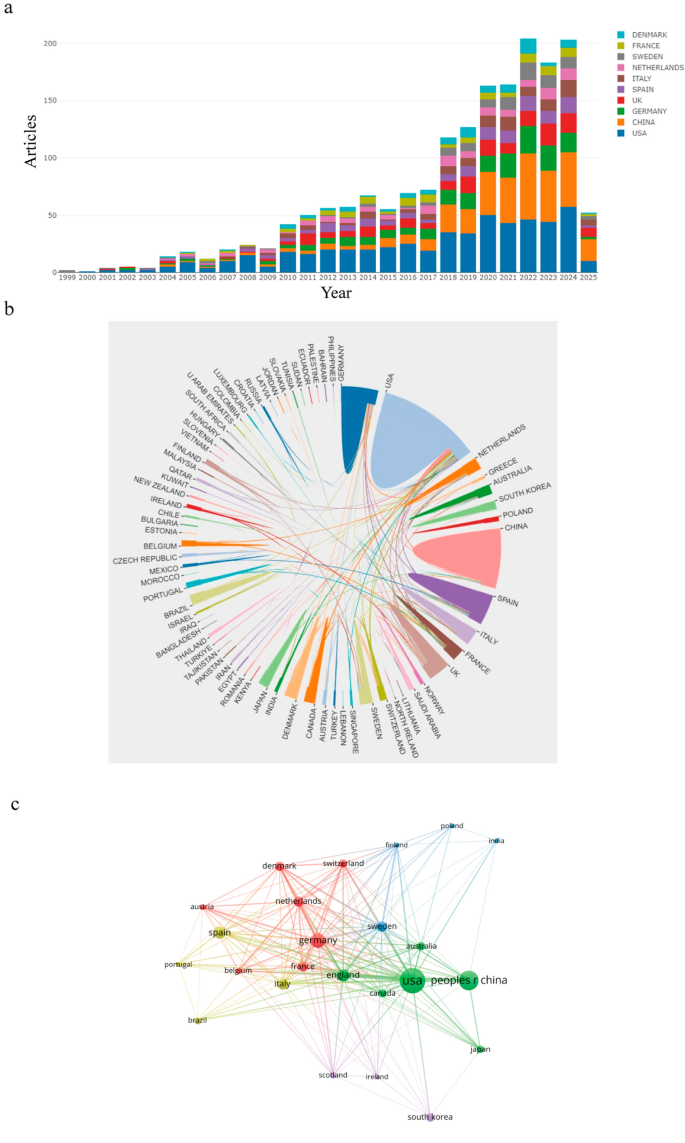
Distribution of published articles across countries and their correlation network. a The growth trends of the top 10 countries in field of proteomics in obesity from 1999 to 2025. b The international network collaboration among the countries/regions, generated using an online platform for bibliometric analysis. c Correlations among countries/regions with over 25 publications, visualized using VOSviewer. Line thickness represents citation strength
Turning to the institutional level, Table 2 lists the ten most prolific institutions. Scandinavian and German institutions were prominently represented. The University of Copenhagen ranked first (n = 43), followed by Maastricht University (n = 35), Karolinska Institute (n = 34), and Harvard Medical School (n = 32). The institutional collaboration network (Fig. 4) shows node size proportional to publication count, while link thickness represents TLS. The University of Copenhagen (TLS = 46), Karolinska Institute (TLS = 44), and Uppsala University (TLS = 34) were the most collaborative institutions in the network.

The co-authorship network map of institutions
Contributions of authors and co-cited authors
To further explore individual-level academic influence, we analyzed the productivity and citation impact of researchers in the field. A total of 11,603 authors and 60,229 co-cited authors were identified. Table 3 lists the top ten most productive and most frequently cited contributors in the field of proteomics and obesity. Among them, five authors published more than ten papers, with Yun Jong Won leading in both publication count (n = 29) and citations (n = 533), and an H-index of 17. Other prolific authors included Choi Jung Won (n = 19), von Bergen Martin (n = 13), Oh Tae-Seok (n = 11), and Chen Shu-Chen (n = 11).
In addition to authorship output, co-citation analysis was used to assess scholarly influence within the intellectual network. The top ten co-cited authors were cited more than 70 times, with Cox J. ranking first (n = 167), followed by Hotamisligil G. S. (n = 124) and Huang D. W. (n = 99). Based on a threshold of ≥ 30 co-citations, 103 authors were included in the co-citation network analysis, providing insight into influential research collaborations and intellectual structure within the field (Fig. 5a, b).
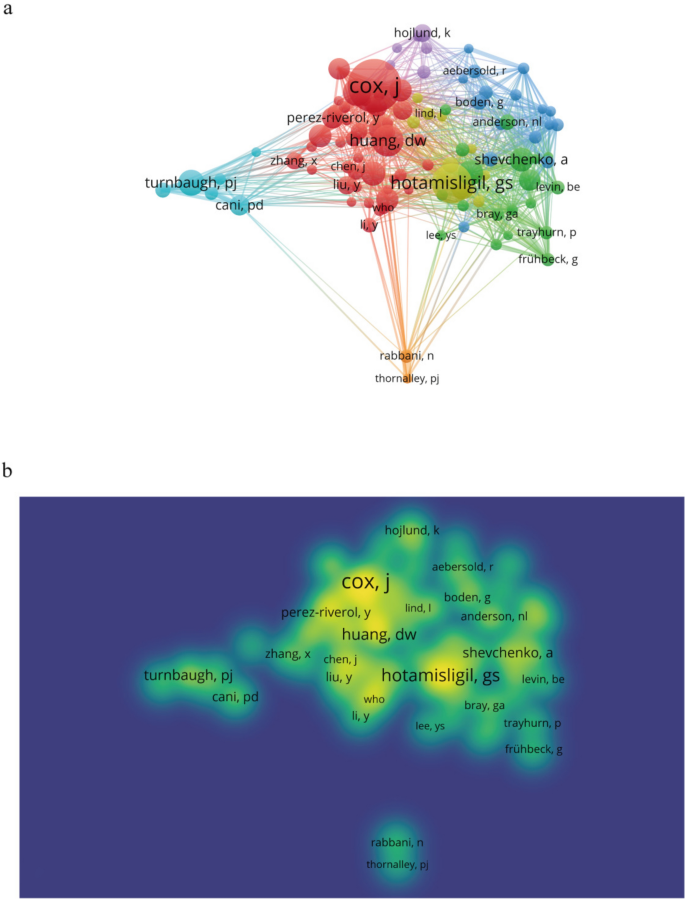
The network (a) and density (b) visualization of co-cited authors
Analysis of journals
To understand the publication outlets shaping the field, we identified the top 15 journals publishing articles on proteomics in obesity research. Proteomics and International Journal of Molecular Sciences were the most productive, with 50 and 48 publications, respectively. Among these journals, Nature Communications had the highest impact factor, while Biochemical and Biophysical Research Communications had the lowest. Molecular & Cellular Proteomics received the most citations (n = 2060), highlighting its influence in the field. Of the 15 journals, 37% were classified as JCR Q1, and 63% had an impact factor above 4.0, suggesting strong journal quality overall (Table 4).
Analysis of co-cited references and citation bursts
To gain insight into how key ideas and research themes have developed, we analyzed co-citation relationships and tracked citation surges across a dataset of 85,033 references. Table 5 lists the top ten most co-cited references in proteomics-related obesity research, each cited at least 36 times. The most frequently co-cited work was by Cox et al. (2008), Nature Biotechnology, cited 84 times, followed by Huang da W et al. (2009), Nature Protocols, with 70 citations.
The co-citation network (Fig. 6a, b) revealed close linkages among foundational works, particularly those introducing key analytical platforms like MaxQuant. In parallel, citation burst analysis (Fig. 7) identified 25 references with rapid citation increases over time. The top-ranked burst was Perez-Riverol et al. (2023–2025; strength = 11.69), followed by another work by the same author and by Szklarczyk et al. (strength = 10.32). These bursts indicate periods of heightened attention to key methodological resources and databases. Overall, burst strengths ranged from 4.21 to 11.69, with durations from 1 to 5 years.
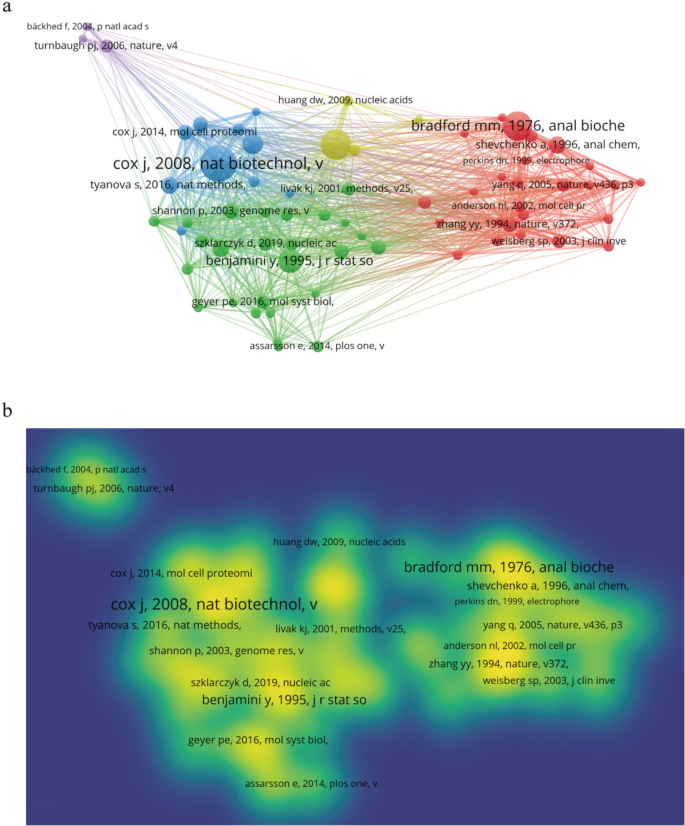
Co-citation collaboration map generated by VOSviewer. a Network visualization of co-cited references. b Density visualization of co-cited references
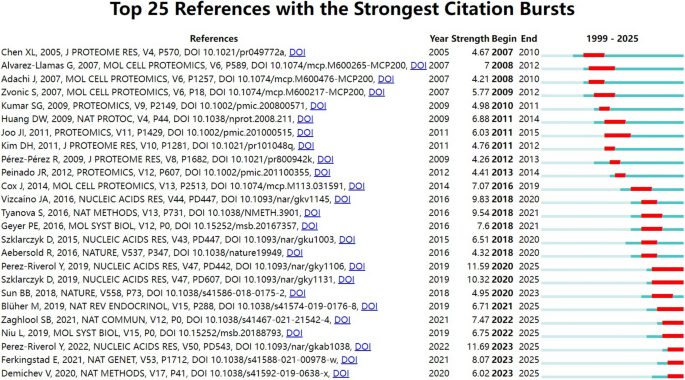
The top 25 high-cited references with the strongest citation bursts, generated by CiteSpace
Figure 8 further depicts the temporal clustering of co-cited references, revealing six major themes. Early research emphasized insulin resistance, systems biology, and the small intestine, whereas recent studies have focused on biomarkers, Mendelian randomization, and intercellular communication, reflecting the field’s evolving priorities.
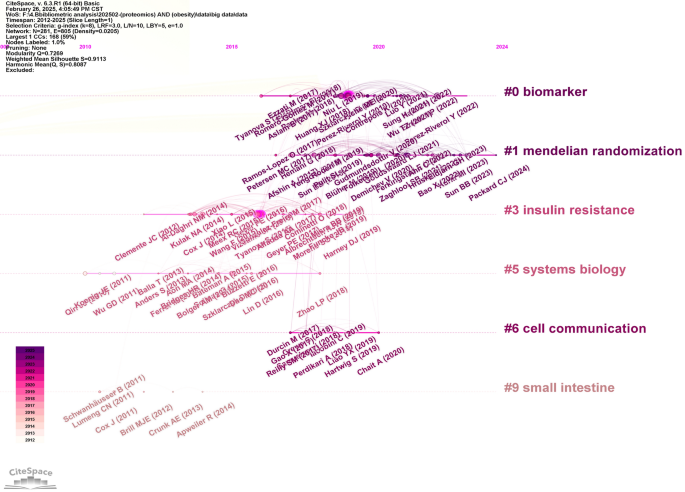
Citespace visualization map of timeline view
Analysis of keyword co-occurrence
To complement citation-based insights, we sorted the recurring keywords and identified the top 20 words with the highest frequency (Table 6). This was conducted by combining similar keywords with the most representative topics in proteomics for obesity researches as comprehensively as possible. Given that “proteomics” and “obesity” were part of the search strategy, their high frequency is unsurprising and not inherently meaningful.
Keyword co-occurrence analysis was used to identify major research themes and their interconnections (Fig. 9a, b). As visualized in Fig. 9a, nine major clusters emerged. Cluster 1 (red) centers on multi-omics approaches and the gut microbiota, with terms like metagenomics, microbiome, and metaproteomics, reflecting growing interest in microbial contributions to metabolic disorders. Keywords such as bariatric surgery and weight loss highlight clinical management, while pregnancy and saliva suggest a shift toward specific populations and non-invasive sampling. Cluster 2 (green) focuses on metabolic and cardiovascular comorbidities, highlighting the frequent use of integrative omics and causal inference methods, including Mendelian randomization. Given the complexity of the full network, we highlight Cluster 1 and Cluster 2 as representative examples of distinct but prominent thematic directions. These clusters capture both mechanistic and translational aspects of obesity research. Additional clusters also contribute to the field’s diversity, though not discussed in detail.
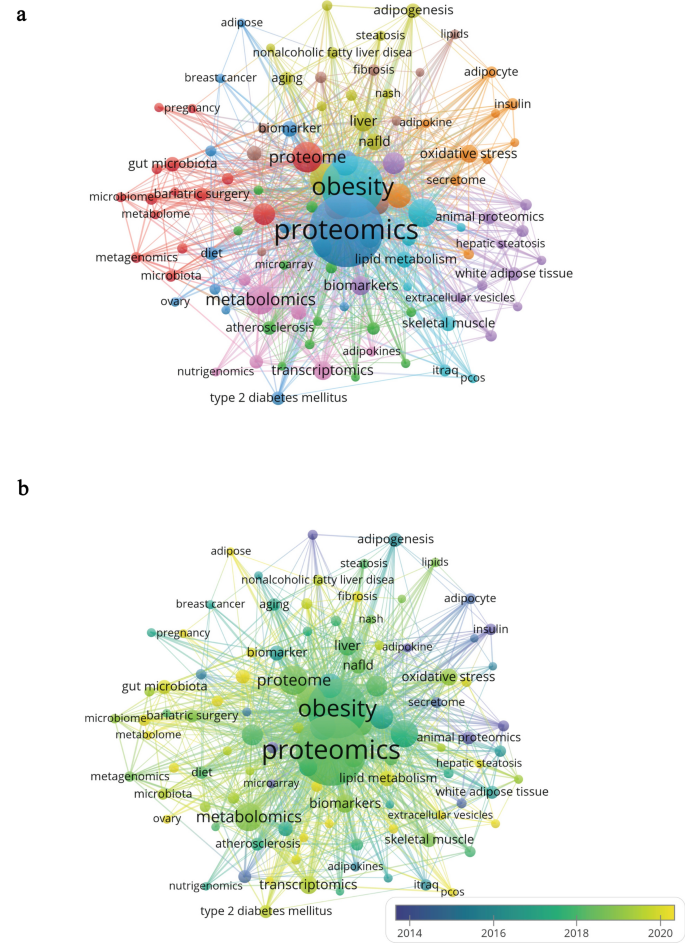
The network (a), overlay (b) of keyword co‑occurrence on proteomics for obesity researches
To further explore how these research foci have changed over time, a temporal overlay analysis was conducted. As shown in Fig. 9b, it illustrates a shift from basic research on adipokines and insulin to more systemic and translational topics, including lipid metabolism, gut microbiota, type 2 diabetes, and PCOS. This trend underscores a broadening of research focus toward clinical application and precision medicine.
